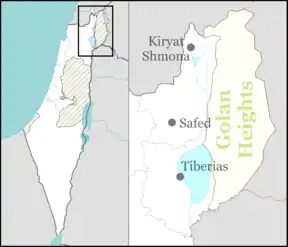Parod
Parod (Hebrew: פָּרוֹד) is a kibbutz in northern Israel. Located in the Upper Galilee near Safed, it falls under the jurisdiction of Merom HaGalil Regional Council. In 2021 it had a population of 606.[1]
Parod | |
|---|---|
 Parod in Galilee | |
 Parod | |
| Coordinates: 32°55′56″N 35°26′2″E | |
| Country | Israel |
| District | Northern |
| Council | Merom HaGalil |
| Affiliation | Kibbutz Movement |
| Founded | 1949 |
| Founded by | Hungarian Jews |
| Population (2021)[1] | 606 |
History
The community was founded in 1949 by Jewish immigrants from Hungary, on land previously belonging to the depopulated Palestinian village of Farradiyya.[2]
The kibbutz was initially named "Gardosh" (from Hungarian "Gárdos") to honor József Gárdos, a Hashomer Hatzair activist and member of the founding nucleus, who was successful at organising the escape of fellow Jews from Nazi-controlled Europe throughout the war, survived the Holocaust but died of illness in 1945, soon after liberation.[3] However, it was later renamed Parod after an ancient Jewish community mentioned once in the Babylonian Talmud, probably located at the site of Farradiyya.[4] The name, which means "separated," might also hint at the community's location on the border between the Upper and Lower Galilee.
Located to the west of Parod is the nearby, ancient hilltop ruin of Bersabe (Khirbet Abu esh-Shebaʿ), a once thriving city (later turned fortress) during the late Second Temple period.[5][6][7][8] To its immediate south is the hilltop ruin of Kafr 'Inan (Kefar Hanniah), a cite once inhabited since Mishnaic times.
Gallery
 Remains of ancient Parod (Farradiyya)
Remains of ancient Parod (Farradiyya) Broken wall
Broken wall Ancient wall of Parod
Ancient wall of Parod Old wall
Old wall Farradiyya in Galilee
Farradiyya in Galilee Ancient walled structure
Ancient walled structure Entrance to Parod
Entrance to Parod
References
- "Regional Statistics". Israel Central Bureau of Statistics. Retrieved 22 February 2023.
- Khalidi, Walid (1992), All That Remains: The Palestinian Villages Occupied and Depopulated by Israel in 1948, Washington D.C.: Institute for Palestine Studies, p. 450, ISBN 0-88728-224-5
- David Gur, Brothers for Resistance and Rescue: The Underground Zionist Youth Movement in Hungary during World War II, edited by Eli Netzer, The Society for the Research of the History of the Zionist Youth Movement in Hungary, 2009 (enlarged and revised edition)
- Uzi Leibner (2009). Settlement and History in Hellenistic, Roman, and Byzantine Galilee. Mohr Siebeck. pp. 116–121.
- See p. 95 in: Avi-Yonah, Michael (1953). "The Missing Fortress of Flavius Josephus". Israel Exploration Journal. 3 (2): 94–98. JSTOR 27924515.
- See p. 38 in: Aviam, Mordechai (1983). "The Location and Function of Josephus' Fortifications in Galilee". Cathedra: For the History of Eretz Israel and Its Yishuv. 28: 33–46. JSTOR 23398973.
- Mordechai Aviam, The Great Revolt in Galilee (Exhibition Catalogue 28), Hecht Museum, University of Haifa: Haifa 2008, pp. 39–52 ISBN 965-7034-18-3
- Oren Tal, "Fortifications of Josephus in Beersheba of the Galilee", pub. in: Jerusalem and the Land of Israel: Sefer Arieh Kindler (ed. Amar & Zohar), Museum Eretz Israel: Ramat Gan 2000, pp. 155–163 (Hebrew)